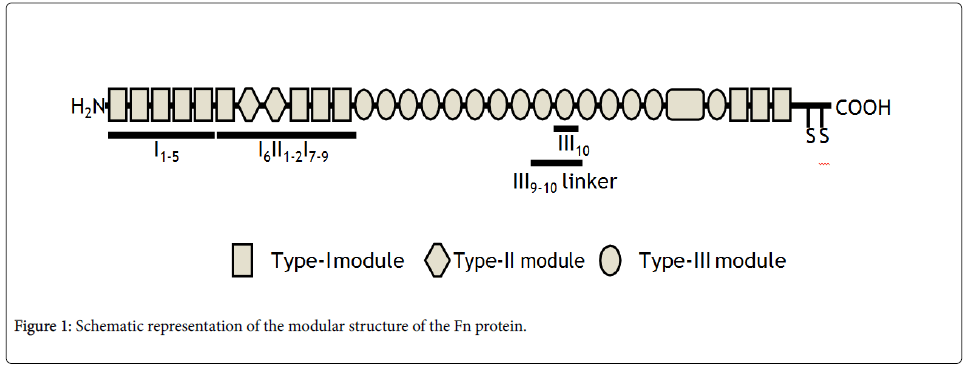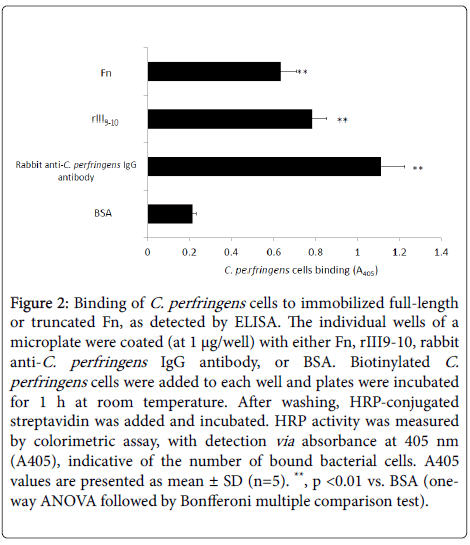Importance of Fibronectin for Clostridium perfringens Adhesion to Host Tissue
Received: 16-Feb-2018 / Accepted Date: 20-Feb-2018 / Published Date: 23-Feb-2018 DOI: 10.4172/2332-0877.1000354
Abstract
Clostridium perfringens, a Gram-positive, spore-forming, obligate anaerobe, is the cause of gas gangrene and food poisoning. Colonization of the host requires adhesion of bacterial cells to injured tissue. We review here recent results regarding the role of fibronectin in the interaction of C. perfringens cells with host collagens.
Keywords: Clostridium perfringens; Fibronectin; Fibronectin-binding proteins
Abbreviations
Fn: Fibronectin; Fbp: Fn-binding protein; BSA: Bovine Serum Albumin; HRP: Horseradish Peroxidase; ELISA: Enzyme-linked Immunosorbent Assay
Mini Review
Clostridium perfringens, the cause of gas gangrene and food poisoning, exerts its pathogenicity by secreting toxins [1]. Delivery of toxins follows C. perfringens colonization of a wound site, which requires the adherence of bacterial cells to damaged host tissue. We investigated the adhesive interaction of C. perfringens cells with collagen, a typical component of connective tissue. Although C. perfringens cells exhibited marginal binding to the surfaces of microplate wells coated with collagen type I, the bacterial cells never exhibited binding to wells coated with collagen type II, collagen type III, or gelatin [2]. However, C. perfringens showed strong binding to immobilized collagens and gelatin when the proteins were precoated with fibronectin (Fn). This observation implies that the adhesion of C. perfringens cells to collagens is an Fn-mediated process.
Fn is a major plasma component, and is also a ubiquitous extracellular matrix protein. Fn plays a pivotal role in many cellular processes, including wound healing, tissue structure formation, and cell migration [3]. Fn is a disulfide-linked homodimeric glycoprotein of approximately 450 kDa, with each Fn monomer consisting of three types of repeating modules: 12 type I, two type II, and 15-17 type III (Figure 1). The N-terminal domain is composed of five type-I modules (I1-5), which correspond to the sites of binding for most bacterial Fn-binding proteins (Fbps) [4], and an adjacent gelatin-binding domain containing four type-I modules and two type-II modules (I6II1-2I7-9). The central part of the Fn polypeptide is composed of 15-17 type-III modules, including the region (III10) responsible for binding of host cells. In contrast to both type-I and type-II modules, type-III modules lack intramodular disulfide bonds.
Tissue injury is usually accompanied by bleeding, leading to coating of connective tissue with Fn, which promotes tissue reconstitution. Given the importance of Fn for the binding of C. perfringens cells to collagens, two questions arise.
The first question is, what are the Fn receptor(s) on C. perfringens cells? To date, we have identified two Fbps, FbpC and FbpD, among the peptidoglycan-associated membrane proteins of C. perfringens [5]; the identification of additional Fbps is expected. FbpC (CPE0625; 56kDa) and FbpD (CPE0630; 45 kDa) are encoded with signal peptides and contain putative cell wall-binding repeats; FbpC and FbpD also harbor a peptidase motif and a peptidoglycan hydrolase motif, respectively. Recombinant forms of both FbpC and FbpD exhibited binding to Fn. Moreover, a preliminary experiment suggested that both anti-FbpC and anti-FbpD antibodies partially inhibit the binding of C. perfringens cells to gelatin coated with Fn (unpublished data). These observations strongly suggest the involvement of both FbpC and FbpD in the adhesion of C. perfringens cells to Fn-coated collagen (represented here by gelatin).
The second question is, what site on the Fn molecule is bound by the bacterial Fn receptors? To elucidate this domain, we employed several anti-Fn monoclonal antibodies that recognize distinct epitopes [6]. Among these reagents, the HB39 monoclonal antibody (IgG isotype), which has been shown to recognize the III9-10 region of Fn, was found to inhibit Fn binding by C. perfringens cells. Furthermore, Fn binding by C. perfringens cells was competitively inhibited by the recombinant III9 fragment of Fn (rIII9), but not by rIII2-4, rIII5-7, rIII8, or rIII10 fragments. Moreover, C. perfringens cells bound weakly, but significantly, to microplate wells coated with either rIII9 or rIII10. In contrast, bacterial cells never bound to wells coated with rIII2-4, rIII5-7, or rIII8. These results suggest that the Fn receptor(s) on C. perfringens cells recognize the III9-10 region of Fn.
Because the individual rIII9 and rIII10 fragments showed weak affinity for C. perfringens cells, we additionally generated a recombinant III9-10 fragment of Fn and tested this preparation for bacterial adherence (Figure 2). The results showed that C. perfringens cells bound immobilized rIII9-10 with avidities similar or higher than that for immobilized Fn. This observation implies that the inter-module linker between III9 and III10 is critical for the binding by the Fn receptors on C. perfringens cells.
Figure 2: Binding of C. perfringens cells to immobilized full-length or truncated Fn, as detected by ELISA. The individual wells of a microplate were coated (at 1 µg/well) with either Fn, rIII9-10, rabbit anti-C. perfringens IgG antibody, or BSA. Biotinylated C. perfringens cells were added to each well and plates were incubated for 1 h at room temperature. After washing, HRP-conjugated streptavidin was added and incubated. HRP activity was measured by colorimetric assay, with detection via absorbance at 405 nm (A405), indicative of the number of bound bacterial cells. A405 values are presented as mean ± SD (n=5). **, p <0.01 vs. BSA (one-way ANOVA followed by Bonfferoni multiple comparison test).
Taken together, these data indicate that Fn plays an important role in the adherence of C. perfringens cells to collagen, a major matrix protein in the connective tissue. At least two Fn-binding proteins, FbpC and FbpD, are involved in the binding of C. perfringens cells to Fn. Specifically; C. perfringens cells target the III9-10 domain of Fn. Indeed, recombinant FbpC and FbpD both appear to bind to the rIII9-10 region of Fn (unpublished data).
Although most bacterial FBPs have been shown to bind the N-terminus of Fn [4], several Fn receptors that bind to the III9-10 region of Fn have been identified, including the Yersinia pestis Ail protein [7] and the Pasteurella multocida PM1665 protein [8]. Ail and PM1665 reportedly bind to III9 and III9-10, respectively. Notably, Ail is critical for the delivery of cytotoxic Yop proteins to host cells and is a major virulence factor for Y. pestis pathogenesis [9]. It will be of interest to determine whether III9-10-mediated Fn binding by C. perfringens cells affects the toxin secretion and/or virulence of this bacterium.
The III10 region contains a unique peptide sequence, RGD that interacts with integrins on the host cell surface [10]. Thus, it is possible that Fn-bearing C. perfringens cells can escape from integrin-mediated binding to host cells, contributing to evasion of immune surveillance. Further work will be needed to assess the biological significance of Fn binding by C. perfringens in the context of the pathogenesis of clostridial gas gangrene and food poisoning.
References
- Rood JI, Cole ST (1991) Molecular genetics and pathogenesis of Clostridium perfringens. Microbiol Rev 55: 621-648.
- Hitsumoto Y, Morita N, Yamazoe R, Tagomori M, Yamasaki T, et al. (2014) Adhesive properties of Clostridium perfringens to extracellular matrix proteins collagens and fibronectin. Anaerobe 25: 67-71.
- Schwarz-Link U, Höök M, Potts JR (2006) Fibronectin-binding proteins of gram-positive cocci. Microbes Infect 8: 2291-2298.
- Katayama S, Kato S, Yamasaki A, Aitani K, Yamasaki T, et al. (2015) Novel cell wall-associated fibronectin-binding proteins of Clostridium perfringens. Int J Anal Bio-Sci 3: 1-9.
- Katayama S, Tagomori M, Morita N, Yamasaki T, Nariya H, et al. (2015) Determination of the Clostridium perfringens-binding site on fibronectin. Anaerobe 34: 174-181.
- Tsang TM, Annis DS, Kronshage M, Fenno JT, Usselman LD, et al. (2012) Ail protein binds ninth type III fibronectin repeat (9FNIII) within central 120-kDa region of fibronectin to facilitate cell binding by Yersinia pestis. J Biol Chem 11: 16759-16767.
- Mullen LM, Nair SP, Ward JM, Rycroft AN, Williams RJ, et al. (2008) Novel adhesin from Pasteurella multocida that binds to the integrin-binding fibronectin FnIII9-10 repeats. Infect Immun 76: 1093-1104.
- Felek S, Kurkonis ES (2009) The Yersinia pestis Ail protein mediates binding and Yop delivery to host cells required for plague virulence. Infect Immun 77: 825-836.
- Plow EF, Haas TA, Zhang I, Loftus J, Smith JW (2000) Ligand binding to integrins. J Biol Chem 275: 21785-21788.
Citation: Hitsumoto Y, Matsunaga N, Katayama S (2018) Importance of Fibronectin for Clostridium perfringens Adhesion to Host Tissue. J Infect Dis Ther 6: 354. DOI: 10.4172/2332-0877.1000354
Copyright: © 2018 Hitsumoto Y, et al. This is an open-access article distributed under the terms of the Creative Commons Attribution License, which permits unrestricted use, distribution, and reproduction in any medium, provided the original author and source are credited.
Share This Article
Recommended Journals
Open Access Journals
Article Tools
Article Usage
- Total views: 3717
- [From(publication date): 0-2018 - Nov 23, 2024]
- Breakdown by view type
- HTML page views: 3027
- PDF downloads: 690


